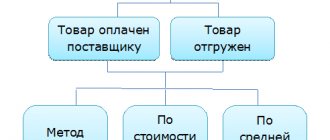Purpose of shares and actions performed with them
JSC issues this security. Their value at face value, circulation, and the amount of the authorized capital (AC) are determined by the first meeting of participants. These data are reflected in the Charter and documents for registration of the issue. The nominal price of the issued shares corresponds to the size of the authorized capital of the joint-stock company.
You can perform the following actions with shares: (click to expand)
- Issue additionally;
- Change the denomination;
- To be repurchased by the issuer;
- Cancel;
- Buy and sell, exchange, give;
- Invest in the management company.
Step-by-step accounting instructions
Step 1. Primary issue. Shares are issued upon opening a joint-stock company in order to form the authorized capital and pay for it. Analytical accounting is carried out according to the stages of its creation. To do this, open subaccounts to the account. 80:
- 1 - declared Criminal Code;
- 2 - subscription;
- 3 - paid.
The relevant accounting entries are presented in the table.
| Dt | CT | Posting Contents |
| 75.1 | 80.1 | The amount of declared capital is reflected based on the Charter |
| 80.1 | 80.2 | The amount of subscription for securities is taken into account |
| 80.2 | 80.3 | Amount of shares actually paid |
| 08, 66, 67, 10, 50, 51, 52, 58, 01, 04 | 75.1 | |
| 19 | 75.1 | VAT allocated (from taxable property contributed to the contribution to the management company) |
| 68 | 19 | VAT is deductible |
Step 2. Accounting for shares on the balance sheet. Shares are strict reporting forms (SSR) and are reflected in the off-balance sheet account of the same name. 006. This is due to the fact that their production and placement occurs over a period of time.
When paying for printing services, make a note:
Dt 20 Kt 60 and Dt 60 Kt 51 - the costs of producing shares are reflected;
Dt 006 - the nominal value of the forms is taken into account.
Step 3. Placement of shares.
The actual disposal of BSO is reflected as follows:
Kt 006 and Dt 80.2 Kt 80.1 - the value of the shares is written off at par.
BSO can be placed at a cost higher than the nominal value. The difference is made according to the following wiring:
Dt 75.1 Kt 83 - the difference in prices is taken into account.
Step 4. Increasing the authorized capital. If the initial capital is paid, participants may decide to increase it. It is formatted like this:
Dt 83, 84 Kt 80 - authorized capital increased due to additional or retained earnings;
Dt 75 Kt 80 - the amount by which the capital will increase at the expense of the funds of the JSC participants is taken into account.
Step 5. Reducing the capital. This procedure is necessary if part of the primary issue securities is not paid for or is not sold within a year, or within two years, according to reporting data, the size of the capital exceeds the amount of net assets (the difference between the value of property and the organization’s liabilities).
Possible transactions to reduce the capital are presented in the table.
| Dt | CT | Content |
| 80 | 81 | Unpaid shares canceled |
| 81 | 75 | The company bought some of the securities and canceled them |
| 80 | 81 | |
| 80 | 84 | The JSC's loss is closed at the expense of the management company |
| 80 | 91 | The nominal value of the shares was reduced voluntarily, the JSC receives income |
| 80 | 75 | Shareholders receive profits |
Step 6. Distribution of dividends. JSC participants have the right to receive income from shares for a certain period. Postings for accrual of dividends differ depending on whether the JSC employee receives them or not:
Dt 84 Kt 70 - for employees;
Dt 84 Kt 75 - for other persons.
Dividend amounts are reduced by the amount of taxes:
Dt 70 Kt 68 - personal income tax of employees;
Dt 75 Kt 68 - personal income tax for individuals and income tax for organizations.
What else is dangerous about currency revaluation?
The simplest example.
The currency value of foreign shares has decreased. But at the same time, the dollar exchange rate has increased.
And what might happen? You made a loss in dollars. But you have earned a profit in rubles, on which you must pay taxes.
Example.
- We buy shares for 1,010 (at an exchange rate of 55 rubles per dollar).
- We sell for 1,009 (at an exchange rate of 65 rubles per dollar).
- Sales income is negative -$1.
- Income from currency revaluation is positive +10,035 rubles.
Total: income tax - +1,304 rubles (13% of 10,035).
To be fair, it is worth noting that the opposite situation is also true.
If the value of a foreign currency asset increases and the dollar exchange rate simultaneously falls, due to currency revaluation, you can completely avoid taxation.
The currency revaluation rule applies to all securities except Eurobonds of the Ministry of Finance.
From 01/01/2019 Income in the form of exchange rate differences is exempt from personal income tax upon the sale (redemption) of Eurobonds of the Ministry of Finance denominated in foreign currency.
In simple terms. Ruble profit (and tax on it) will be recalculated at the Central Bank exchange rate on the day of sale (redemption) of the securities. Regardless of the dollar exchange rate on the day of purchase.
I bought a Eurobond for $1,000 and sold it for $1,001. Profit = $1. We convert at the current rate (on the day of sale) into rubles. All.
The second unpleasant moment is the so-called tax on the weakening of the ruble
If the national currency weakens (and statistically, the dollar always strengthens against the ruble over long periods), the investor will be forced to pay higher income taxes. We get a kind of tax on inflation or depreciation of the ruble. The more the ruble weakens, the “more” your profit will be. And the more taxes you will have to pay in the end.
I recommend: Air tax or how inflation affects investor profits
Over the past 20 years, ruble inflation has been about 7%. For the dollar - about 2%. The difference is 5%. It turns out that every year the investor will be subject to an additional tax of 0.65%. It doesn't seem like much. But in some cases this will be a very serious loss.
A striking example is the purchase of foreign assets for a long term (for example, independent savings for retirement). On average, with this scheme, after 20 years, due to currency revaluation, the investor will lose an additional 15% of profit in the form of taxes. In addition to the standard tax of 13%.
If in money. If you invest $100,000 for 20 years, additional losses from currency revaluation will amount to 8,300 bucks.
What is the result?
It turns out that due to currency revaluation, the investor is almost always forced to pay double tax:
- To increase the value of assets.
- On the growth of foreign currency exchange rates.
Accounting for stock purchases
A company may purchase shares of another firm through an allotment of shares in an initial public offering or through a purchase and sale document. This must be reported to the tax office within one month from the date of purchase. An exception is equity participation in LLCs, business partnerships, with a share of less than 10%.
Purchased shares are accounted for as financial investments. The accounting procedure is fixed in PBU 19/02.
Analytics is carried out individually or in homogeneous batches. The analytics must reflect the following data: name of the issuer, details of the share, nominal and purchase price, acquisition costs, number of securities (securities), transaction date, storage procedure, etc.
Investments in securities are recorded at their initial cost. It includes expenses:
- To purchase;
- For information services and consultations;
- Encouraging intermediaries;
- Others caused by the acquisition;
- VAT on costs.
The costs of purchasing shares can be included in other expenses if their value differs slightly from the price of the securities. Costs are recognized as other in the same reporting period in which the shares are accounted for. The initial cost does not include general business expenses, credit funds and interest on them.
Example. Purchase of shares from OJSC
Parus LLC bought 15 shares from Mayak OJSC through an intermediary, Matros LLC. The remuneration for services amounted to 2832 rubles, including VAT - 432 rubles. The price of one paper is 5,500 rubles. The costs of purchasing Parus shares will be taken into account as other expenses, since they are immaterial. The significance criterion is fixed in the accounting policy in the amount of 5% of the value of securities.
To account for settlements with Matros LLC, the accountant of Parus LLC opened an account. 76 subaccount 5 “Settlements with intermediaries.” He reflected the purchase of shares as follows:
Dt 58.1 Kt 76.5 82500 rub. (5500 * 15) - shares purchased;
2832 / (5500 * 15) * 100% = 3.4% - intermediary costs are insignificant;
Dt 91.2 Kt 76.5 2832 rub. — purchase costs are written off as other costs;
Dt 76.5 Kt 51 85332 rub. (82500 + 2832) - money is transferred to the intermediary.
The purchased shares are stored at the enterprise's cash desk or in a special storage facility (depositary). Its functions include the safety of BSO and their accounting. He receives a certain percentage and resells the securities on behalf of the owner.
How to reflect shares in accounting
Increasing the authorized capital of a joint stock company is possible in two ways: increasing the par value of shares or placing additional shares (Clause 1, Article 28 of the Law on Joint Stock Companies). Moreover, in accordance with paragraph 1 of Article 39 of this Law, the placement of additional shares can be carried out in one of three ways :
— subscription (open or closed);
— conversion;
— distribution among shareholders.
Let us consider the content of corporate events carried out during an additional issue of shares placed by private subscription, and in the case where the additional issue of shares is not accompanied by state registration of a securities prospectus.
Registration of a prospectus for the issue of securities is required if shares are placed by public subscription or by private subscription among a circle of persons whose number exceeds 500. In this case, more stringent requirements for disclosure of information are provided in order to ensure that possible investors in the securities market receive the necessary information.
Payment for shares of an additional issue can be made either in cash or in various property (under an exchange agreement), which must be preliminarily assessed by an independent appraiser. The article will discuss the first option for paying for shares.
The process of additional issue of shares includes 5 stages:
1. Making a decision on the placement of equity securities;
2. Approval of the decision on additional issue of equity securities;
3. State registration of an additional issue of equity securities;
4. Placement of issue-grade securities;
5. State registration of the report on the results of the additional issue of equity securities.
Each stage includes corporate activities that must be carried out consistently and in compliance with established deadlines.
1. Making a decision on the placement of equity securities
At this stage, a meeting of the Board of Directors is held, which determines the cost of one share, and the General Meeting of Shareholders, which decides to increase the authorized capital by issuing additional shares of the company.
If the company's charter does not contain provisions on authorized shares (that is, it does not provide for the possibility of an additional issue), it is necessary that at this stage the shareholders decide to make appropriate changes to the charter (on the number of authorized shares and the rights of shareholders provided by these shares after their placement) (clause 3 of article 28 of the Law on Joint Stock Companies). If such a decision was made at the General Meeting of Shareholders, the Joint Stock Company is obliged to register these changes with the Federal Tax Service.
2. Approval of the decision on additional issue of securities
The Board of Directors approves the decision on additional issue of shares. If the organization does not have a Board of Directors, the decision is approved by the management body performing the functions of the Board of Directors. Typically this body is the general meeting of shareholders. Documents for state registration of an additional issue of securities must be submitted no later than three months from the date of approval of the decision on their issue.
3. State registration of an additional issue of equity securities
According to Decree of the President of the Russian Federation dated July 25, 2013 N 645, the Federal Financial Markets Service of Russia was abolished. Its functions have been transferred to the Bank of Russia.
Thus, the Bank of Russia Service for Financial Markets carries out the functions of the abolished FSFM of Russia, including registering additional issues of shares.
For state registration of an additional issue of securities, the documents provided for by the Standards for the Issue of Securities (approved by the Bank of Russia on August 11, 2014 N 428-P) (hereinafter referred to as the Standards) are submitted to the registering authority.
1) application for state registration of an additional issue of securities;
2) issuer's questionnaire;
3) a copy of the document confirming the state registration of the issuer;
4) decision on additional issue of securities;
5) Minutes of the Board of Directors on determining the placement price of shares;
6) Minutes of the general meeting of shareholders on increasing the authorized capital;
7) Minutes of the meeting of the Board of Directors on approval of the decision on the additional issue of securities;
 a copy of the charter (constituent documents) of the issuer in the current edition with all amendments and (or) additions made to them;
a copy of the charter (constituent documents) of the issuer in the current edition with all amendments and (or) additions made to them;
9) payment order (receipt of the established form in the case of cash payment), which confirms the fact of payment by the issuer of the state duty collected in accordance with the legislation of the Russian Federation on taxes and fees for state registration of an additional issue of securities;
10) inventory of submitted documents;
11) other documents provided for by the Standards.
The issuer must provide the registration authority with a set of documents on paper and electronic media. The decision on an additional issue and the issuer's questionnaire must be filled out in accordance with the Standards and compiled using a special program - an electronic questionnaire, which is freely available on the official websites of the SBR and recorded on electronic media in questionnaire format. Since at the moment the electronic questionnaire does not contain some provisions of the new Standards, the Decision on the additional issue and the issuer’s questionnaire in .doc or .rtf format with changes taking into account the new provisions must also be placed on the electronic medium.
Within 20 days from the date of receipt by the registering authority of documents and electronic media, it is obliged to carry out state registration of an additional issue of securities or make a reasoned decision to refuse its state registration
In the process of reviewing documents, the RBI may have comments on the documents. In this case, during the process of registering a decision on an additional issue of securities, a verification of the accuracy of the information contained in the provided documents may be ordered, or the state registration of the decision on an additional issue may be suspended. The period of suspension cannot be more than 30 days.
4. Placement of issue-grade securities
The placement of securities by the issuer begins with transactions (conclusion of agreements) aimed at the alienation (sale) of securities of an additional issue to their first owners, in accordance with the terms of the registered decision on the additional issue of securities. The issuer must send a transfer order to the registrar to make relevant entries in the register of shareholders.
The placement is carried out within the time limits provided for by the registered decision on the additional issue of shares. This period cannot exceed one year from the date of state registration of the additional issue of equity securities.
Also, during the placement process, changes may be made to the registered text of the decision on the additional issue of shares. Such changes are subject to mandatory registration with the SBR.
5. State registration of a report on the results of an additional issue of equity securities
No later than 30 days after the completion of the placement of issue-grade securities, the issuer is obliged to submit to the Bank of Russia a report on the results of the additional issue of issue-grade securities (Clause 1, Article 25 of the Law on the Securities Market).
For state registration of a report on the results of an additional issue of securities, the documents provided for by the Issue Standards are submitted to the registration authority:
1) application for state registration of a report on the results of an additional issue of securities;
2) report on the results of the additional issue of securities;
3) a copy (extract from) the minutes of the meeting (session) of the authorized management body of the issuer (order, instruction or other document of the authorized person), which made the decision to approve the report on the results of the issue (additional issue) of securities, indicating if this the decision was made by a collegial governing body, quorum and voting results for its adoption;
5) a certificate from the issuer regarding its compliance with information disclosure requirements at the stages of state registration of an additional issue of securities;
6) a document confirming the existence of a decision on the preliminary approval of transactions for the placement of securities of an issuer that is a business company of strategic importance for ensuring the defense of the country and the security of the state, if such transactions are permitted subject to the presence of the specified decision on their preliminary approval;
 If the issuer refuses to place securities and submits a report on the results of their issue (additional issue), containing information that no securities have been placed, a copy (extract from) the minutes of the meeting (session) of the issuer's authorized management body ( order, instruction or other document of an authorized person) by which a decision was made to refuse to place securities, indicating, if this decision was made by a collegial management body, the quorum and the results of voting for its adoption;
If the issuer refuses to place securities and submits a report on the results of their issue (additional issue), containing information that no securities have been placed, a copy (extract from) the minutes of the meeting (session) of the issuer's authorized management body ( order, instruction or other document of an authorized person) by which a decision was made to refuse to place securities, indicating, if this decision was made by a collegial management body, the quorum and the results of voting for its adoption;
9) payment order (receipt of the established form in the case of cash payment), which confirms the fact of payment by the issuer of the state duty collected in accordance with the legislation of the Russian Federation on taxes and fees for state registration of a report on the results of an additional issue of securities;
10) inventory of submitted documents;
11) other documents provided for by these Standards.
The issuer submits to the registration authority the documents required in accordance with the Standards for state registration of the report on the results of an additional issue of securities, in one copy, with the exception of the report on the results of the issue (additional issue), submitted in three copies.
The text of the report on the results of the additional issue of securities is also submitted to the registration authority on electronic media and in a format that meets the requirements of the federal executive body for the securities market.
If, during the placement of securities, in the end, not a single security of an additional issue is placed, or the decision on an additional issue of securities placed by subscription establishes the share of securities, if not placed, the additional issue is considered failed, such additional issue of securities is recognized by the registration authority failed, and its state registration is cancelled.
Registration of a report on an additional issue of securities is carried out within 14 days from the date of submission of documents to the SBR.
In the process of reviewing documents, the RBI may have comments on the documents. In this case, during the process of registering a report on the results of an additional issue of securities, a verification of the accuracy of the information contained in the provided documents may be ordered, or the state registration of a report on the results of an additional issue of securities may be suspended. The period of suspension cannot be more than 30 days.
After registering the report on the results of the additional issue, the issuer must make appropriate changes to its constituent documents in terms of increasing the size of the company’s authorized capital.
ATTENTION: Be sure to comply with the disclosure requirements for additional issuance of securities. For failure to comply with information disclosure requirements, the fine currently ranges from 700,000 to 1,000,000 rubles.
Our company will help you register an additional issue of securities. Services for registering an additional issue of securities include consulting at the stages of the issue, preparing a package of documents, submitting a package of documents to the registration authority and receiving documents on registration of an additional issue of securities.
The cost of services for additional issue of securities averages from 35,000 rubles. An additional fee for the issue (additional issue) of securities placed by subscription is paid at 0.2% of the nominal value of the issue of securities.
For questions regarding additional issue of shares, please call.
Accounting for shares when selling: postings
The owner of shares can dispose of them at his own discretion: (click to expand)
- Sell;
- Invest in management companies of other companies;
- Pay for goods;
- Transfer free of charge.
The sale of shares in accounting is shown as a disposal of financial investments (clause 25 of PBU 19/02):
Dt 76 Kt 91.1 - securities sold;
Dt 91.2 Kt 58.1, 76 - the cost of securities and selling expenses are written off.
Types of shares, their significant differences
Shares can be simple or preferred.
| Index | Simple | Privileged |
| Interest payment | From the remaining profit after settlement of preferred securities | As a matter of priority |
| Payout percentage | Depends on income | Fixed |
| The owner's right to vote at the meeting of participants | It has | Doesn't have |
| Receiving a share of assets upon liquidation of a joint stock company | Secondary right | First priority |
Under ordinary dividends, dividends are paid from the part of the profit remaining after paying a percentage of income under preferred ones.
Dividends: accrual and payment, accounting entries
Let's look at an example.
By decision of the founders, LLC “Company” pays part of the net profit to three participants on February 15, 2018: JSC “Founder”, Ivanov S.M., Semenov K.S. - each in the amount of 100,000 rubles. All recipients are tax residents of the Russian Federation.
| date | Contents of operation | Sum | Debit | Credit |
| A decision was made to transfer part of the positive financial result to the founders: 100 000 × 3 | 300 000 | 84 | 75 | |
| Personal income tax has been calculated from transfers to individuals: (100 000 × 2) × 13 % | 26 000 | 75 | 68 | |
| Profit tax has been calculated on income to the organization: 100 000 × 13 % | 13 000 | 75 | 68 | |
| Listed by decision on distribution of part of the financial result: 300 000 – 26 000 – 13 000 | 261 000 | 75 | 51 | |
| Withheld personal income tax is transferred to the budget | 26 000 | 68 | 51 | |
| Withheld income tax transferred to the budget | 13 000 | 68 | 51 |
Documents required for transactions
Shares are acquired under a purchase and sale agreement. It must be in writing and must contain the following information:
- Details of the parties;
- Information about the object of the transaction: issuer, details, par value, etc.;
- Cost of securities upon purchase;
- Other conditions: payment terms, fines, etc.
The purchase of shares is formalized by a randomly drawn up primary document. For example, an act of acceptance and transfer. The acquisition is also confirmed by extracts from the acquirer’s account or from the register.
Payment for shares is reflected in bank statements and payment documents. When securities are stored at the cash desk, they are recorded in a special register (book). The document contains basic information about the shares and is kept in two copies.
Line 4222 “in connection with the acquisition of shares of other organizations (participatory interests)”
The indicator in this line represents the amount of payments in connection with the acquisition of shares of joint-stock companies, shares in the authorized capital of limited liability companies, etc.
Line 4222 does not reflect payments in connection with the acquisition of equity financial investments acquired for the purpose of resale in the short term (paragraph “d”, paragraph 10, paragraph “z”, paragraph 9 of PBU 23/2011).
Accounting data used to fill out line 4222 “in connection with the acquisition of shares of other organizations (participation interests)”
When filling out line 4222, data on credit turnover is used in correspondence with the accounts for accounting for settlements for shares (shares) or with account 58, subaccount 58-1 “Shares and shares”, according to the accounts:
— 50 “Cashier”;
— 51 “Current accounts”;
— 52 “Currency accounts”;
— 55 “Special bank accounts”,
as well as about credit turnover on accounts 58 (analytical account for accounting for cash equivalents), 76 (analytical account for accounting for cash equivalents that are not financial investments) in connection with the disposal of cash equivalents transferred as payment.
The resulting indicator is indicated in line 4222 in parentheses.
Column “For the reporting year”, line 4222 “in connection with the acquisition of shares of other organizations (participation interests)” = Credit turnover for the reporting year on accounts 50,51,52 (If, shortly before payment in foreign currency, the organization, as part of its normal activities, changes rubles for the required amount of foreign currency, then the cash flow is reflected in the Cash Flow Statement in the amount of rubles actually paid without intermediate conversion of foreign currency into rubles (paragraph 3 of clause 18 of PBU 23/2011)),55 in correspondence with accounts for accounting settlements with sellers of shares (shares) or with account 58, subaccount 58-1 “Shares and shares” + Credit turnover for the reporting year on accounts 58 and 76 in connection with the transfer of shares (shares) as payment
In the “For the previous year” column, in general, data from the “For the reporting year” column of the Cash Flow Statement for this previous year is transferred.
Example of filling out line 4222 “in connection with the acquisition of shares of other organizations (participatory interests)”
Turnover for 2014 on the credit of account 51 in correspondence with account 76 (analytical account for accounting for payments for shares). There are no other payments for the acquired shares (shares).
rub.
| Index | Sum |
| 1 | 2 |
| Turnover on the credit of account 51 in correspondence with account 76 (analytical account for accounting for settlements for shares) | 1 600 000 |
Fragment of the Cash Flow Statement for 2013
| Indicator name | Code | For 2013 | For 2012 |
| in connection with the acquisition of shares of other organizations (participatory interests) | 4222 | — | — |
Solution
Payments in connection with the acquisition of shares (participatory interests) in other organizations are:
in 2014 - 1600 thousand rubles;
in 2013 - absent (a dash is placed).
A fragment of the Cash Flow Statement will look like this.
| Indicator name | Code | For 2014 | For 2013 |
| in connection with the acquisition of shares of other organizations (participatory interests) | 4222 | (1600) | — |
Annual share reporting
The requirements for financial reporting of joint stock companies are established by the accounting law. It is compiled annually and includes a balance sheet, a form on profits and losses, changes in capital, cash flows and their intended use, appendices, an explanatory note, and audit results.
To disclose information on the issue of shares, JSCs must prepare an annual report. The requirements for its content are in Regulation No. 454-P dated December 30, 2014. The document must contain the following information:
- JSC's place in the industry;
- Key activities;
- Report of the management board on the results of the development of the joint-stock company;
- Data on the volume of energy resources consumed per year (by quantity and amount);
- Development forecast;
- Interest payment report;
- Indication of the reasons for the risk;
- List of major transactions completed during the year and detailed information about them (conditions, responsible person, etc.);
- The composition of the supervisory board, changes in it, biography of members, transactions carried out by them;
- Other information (Article 70.3 of Regulation No. 454-P).
According to the Law on JSC No. 208-FZ of December 26, 1995, public companies must disclose data on the annual report and accounting final papers, a securities prospectus, and report on the holding of a meeting of shareholders. The volume and procedure for providing information is regulated by Regulation No. 454-P.
Calculation of dividends to founders: postings from the payer
The accrual of dividends by entries in the accounting of the person paying the dividends must be made on the date when the meeting of shareholders (participants) decided to pay them. Accounting for settlements with founders is kept on account 75, if the founder is not an employee of the enterprise, or on account 70, if the founder and director are the same person.
The entries associated with the accrual of dividends will be as follows:
- Dividends were accrued to the founders (posting as of the date of the decision with a breakdown in the analytics of accounts 70 and 75 by participants): Dt 84 Kt 75 - for participants-legal entities and individuals who do not work for the dividend payer;
- Dt 84 Kt 70 - for individual participants who are employees of the dividend payer.
- Dt 75 Kt 68 - for participants-legal entities (income tax) and individuals who do not work for the dividend payer (personal income tax);
- Dt 75 Kt 51 (50) - to participants-legal entities and individuals who do not work for the dividend payer;
- Dt 68 Kt 51 - broken down by type of tax (profit or personal income tax).
- Dt 75 Kt 84 - listed on account 75.
To learn how account 84 is reflected in the balance sheet, read the article “Procedure for compiling a balance sheet (example).”





